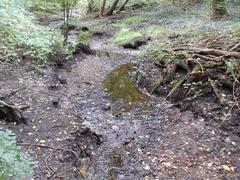
Canal Alster-Trave Visiting Hours, Tickets, and Hamburg Historical Sites Guide
Date: 15/06/2025
Introduction
The Canal Alster-Trave, historically known as the Alster-Beste-Trave-Kanal, is a remarkable waterway connecting Hamburg and Lübeck in Northern Germany. Constructed in the 16th century as a direct trade route between the North Sea and the Baltic Sea, it stands as a testament to Hanseatic ambition and early modern engineering. Today, the canal and its associated waterways are integral to Hamburg’s urban landscape, offering visitors a unique blend of history, architecture, and natural beauty. This comprehensive guide delivers detailed historical context, practical information on visiting hours and tickets, accessibility tips, and recommendations for exploring Hamburg’s historical waterways.
Contents
- Introduction
- History of the Canal Alster-Trave
- Medieval Ambitions and Hanseatic Trade
- Construction and Engineering Challenges
- Legal Disputes and Decline
- Legacy and Modern Significance
- Visiting the Canal Alster-Trave
- Visiting Hours and Access
- Guided Tours, Cruises, and Activities
- Accessibility
- Nearby Attractions
- Travel Tips
- Visitor Experience
- What to Expect on Canal Tours
- Key Sights Along the Waterway
- Practical Advice and Seasonal Highlights
- Frequently Asked Questions (FAQ)
- Alster Kanalfahrt: Tickets and Cruise Planning
- Booking, Prices, and Timetables
- Alternative Exploration Options
- Safety, Sustainability, and Comfort
- Summary and Visitor Tips
- Sources and Further Reading
History of the Canal Alster-Trave
Medieval Ambitions and Hanseatic Trade
The origins of the Canal Alster-Trave are rooted in the economic rivalry and cooperation between the Hanseatic cities of Hamburg and Lübeck during the late Middle Ages. As prominent members of the Hanseatic League—a powerful commercial confederation—both cities sought a direct waterway to facilitate trade between the North Sea (Hamburg) and the Baltic Sea (Lübeck), bypassing the long, hazardous sea route around the Skagerrak and the toll-laden Stecknitz Canal (hamburg.com; bargfeld-stegen.de).
Construction and Engineering Challenges
Inspired by the Stecknitz Canal (completed 1398), Hamburg and Lübeck launched the Alster-Trave Canal project in the mid-15th century. Despite initial enthusiasm and agreements with local rulers, the effort stalled due to daunting technical and financial hurdles—difficult terrain, the need for numerous locks, and escalating costs. The project was revived in the early 16th century, and between 1525 and 1529, the canal was completed with a total length of about 91 kilometers. It included 23 locks to manage a 28-meter elevation difference and was considered a major engineering feat for its time. The canal enabled barges to transport timber, peat, salt, and other goods between the two cities (travestreifzug.de).
Legal Disputes and Decline
The canal’s construction sparked legal disputes, particularly with the Duchy of Lauenburg, which feared loss of revenue from the Stecknitz Canal. Despite legal wrangling, the Alster-Trave Canal operated for several decades. However, high maintenance costs, frequent flooding, and the emergence of alternative transportation (notably the railway in the 19th century) led to its abandonment. By the late 1500s, critical sections were neglected, and the canal was eventually rendered obsolete (bargfeld-stegen.de; wikiwand.com).
Legacy and Modern Significance
Although the canal was a short-lived commercial venture, its influence persists. The canal’s route shaped Hamburg’s urban development, and remnants are still visible in the landscape north of the city. Today, the canal and its connected waterways form the backbone of Hamburg’s network of canals (Fleete), contributing to its unique cityscape, recreational life, and cultural identity (travestreifzug.de).
Visiting the Canal Alster-Trave
Visiting Hours and Access
The historical canal route and its adjacent walking and cycling paths are accessible year-round at no cost. No entrance fees or tickets are required for exploring the trails or natural areas. Key access points include Kayhude, Sülfeld, and the urban stretches within Hamburg.
Guided Tours, Cruises, and Activities
While the original canal is no longer navigable, Hamburg’s modern canal network offers a variety of experiences:
- Fleetfahrt Canal Cruises: Guided boat tours depart from Jungfernstieg and Landungsbrücken, traversing the Alster, Speicherstadt, and city canals. Tours typically operate daily from 10:00 AM to 6:00 PM, with longer hours in summer (hamburg-travel.com).
- Public Ferries: HADAG ferry lines 61 and 72 provide self-guided canal journeys, included with the Hamburg CARD (Frasers Hospitality).
- Guided Walks & Cycling Tours: Local operators offer themed walks and bike tours along the historic canal routes.
Accessibility
Most tour boats are wheelchair-accessible, but it is advisable to confirm with operators before booking. Promenades and towpaths are generally flat and suitable for visitors with moderate mobility, though some rural sections may be uneven.
Nearby Attractions
- Speicherstadt: UNESCO World Heritage warehouse district with museums and cafes.
- HafenCity: Modern waterfront redevelopment with striking architecture.
- Lübeck Old Town: Accessible from the canal’s eastern end, known for its medieval charm.
- Alster Lakes: Popular for boating, jogging, and lakeside relaxation.
- Kayhude and Bad Oldesloe: Towns featuring remnants of the historic canal and local museums.
Travel Tips
- Dress in layers and bring rain protection due to Hamburg’s variable weather.
- Book cruises in advance, especially during peak seasons.
- Bring a camera, snacks, and sun protection for extended tours.
- Use public transport (Hamburg CARD) for easy access and discounts.
Visitor Experience
What to Expect on Canal Tours
- Fleetfahrt Canal Cruises: These guided tours take you through Hamburg’s most scenic waterways. Commentary is often available in German and English, providing historical context and highlighting architectural landmarks (Sommertage).
- Alster Kanalfahrt: Cruises through the Alster canals, offering views of stately villas, lush gardens, and the city’s historic bridges. Tours last about 1.5 to 2 hours and depart from Jungfernstieg (hamburgtouring.com; hamburger-rundfahrten.com).
Key Sights Along the Waterway
- Speicherstadt: Red-brick warehouses, now housing museums and cafes.
- Binnenalster and Außenalster: Artificial lakes at the city’s heart, perfect for panoramic views and recreation.
- Historic Bridges: Brooksbrücke, High Bridge, and others, some dating back centuries.
- Canal Islands: Brook, Kehrwieder, Wandrahm—once merchant hubs, now part of Hamburg’s modern cityscape.
Practical Advice and Seasonal Highlights
- Best Times: Late spring to early autumn (May–September) for mild weather and frequent cruise departures.
- Sunset Cruises: Evening tours offer stunning cityscape views.
- Winter: Cruises are limited, but walking and cycling are still possible; festivals and skating occur if the Alster lakes freeze.
Alster Kanalfahrt: Tickets and Cruise Planning
Booking, Prices, and Timetables
- Ticket Price: Adults €20, Children under 16 €4 (hamburgtouring.com).
- Booking: Reserve tickets online or at Jungfernstieg; advance booking is recommended during peak months (hamburger-rundfahrten.com).
- Schedule: Cruises depart twice daily, with slight variations by season. Check official timetables for current hours (hamburger-rundfahrten.com).
Alternative Exploration Options
- Canoe, Kayak, or Pedal Boat Rental: Explore the Alster lakes at your own pace—no license required (hamburg.com).
- Walking and Cycling: Well-maintained paths circle the lakes and canal routes.
- Self-guided Ferries: HADAG lines covered by Hamburg CARD for budget-friendly canal access.
Safety, Sustainability, and Comfort
- Accessibility: Most boats accommodate those with limited mobility—confirm in advance.
- Dress: Casual, layered clothing and grippy shoes are recommended.
- Sustainability: Many operators use eco-friendly boats; dispose of trash responsibly and respect local wildlife.
- Public Transport: Jungfernstieg is a major hub; parking is limited, so public transit is advised (hamburg-travel.com).
Frequently Asked Questions (FAQ)
Q: Are tickets required to visit the canal or towpaths?
A: No, walking and cycling paths are free to access year-round.
Q: How do I book a canal cruise?
A: Book online in advance or at Jungfernstieg ticket offices. Public ferries require only a valid HVV or Hamburg CARD.
Q: Are cruises suitable for families?
A: Yes, children are welcome, and reduced rates are available.
Q: Are tours available in English?
A: Many operators provide English commentary or audio guides—confirm when booking.
Q: What should I bring?
A: Weather-appropriate clothing, camera, snacks, and reusable water bottle.
Q: Is the canal accessible for visitors with mobility challenges?
A: Most boats and promenades are accessible, but confirm details with your operator.
Q: When is the best time to visit?
A: May to September for pleasant weather and regular tours.
Summary and Visitor Tips
The Canal Alster-Trave is a living link to Hamburg’s Hanseatic legacy, offering a diverse range of experiences for history enthusiasts, architecture fans, and casual travelers. Whether you’re joining a guided cruise, exploring on foot or by bike, or simply relaxing by the water, the canal presents a unique perspective on the city’s past and present. Plan ahead for tickets and schedules, dress for the weather, and enjoy the many attractions along the route. For an enriched experience, download the Audiala app for guided audio tours and insider tips.
Sources and Further Reading
- Alster-Trave Canal: History, Visitor Information, and Exploring Hamburg’s Historic Waterway
- Exploring the Canal Alster-Trave: Visiting Hours, Tickets, and Hamburg’s Historic Waterway
- Visitor Experience
- Practical Visitor Tips
- HafenCity History
- Frasers Hospitality – Things to Do in Hamburg
- Time Out – Hamburg Travel Tips
- Chasing Chanelle – Is Hamburg Worth Visiting?
- Hamburg.com – Hamburg by Boat
- Hamburger Rundfahrten – Alster Kanalfahrt





















































































